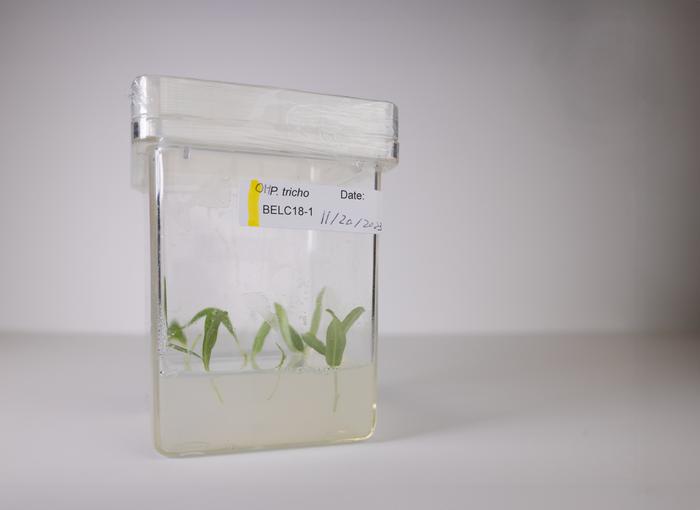A team of U of T Scarborough researchers have discovered that the waxy protective barrier around plants might play a role in sending chemical signals to other plants and insects.

Credit: Don Campbell
A team of U of T Scarborough researchers have discovered that the waxy protective barrier around plants might play a role in sending chemical signals to other plants and insects.
The research, published in the journal Proceedings of the National Academy of Science, might eventually be harnessed to develop stronger plants that can deal with challenging environmental conditions.
For the study researchers looked at cuticular waxes, a thin layer that plants deposit on their surface to help protect them from losing water. “These waxes act as a physical defense,” says Eliana Gonzales-Vigil, an assistant professor in the department of biology who led the study.
“If plants didn’t have this wax, they would dry out very quickly. It’s the reason you see water drops beading on the surface of leaves. Plants evolved this trait over time when they moved from growing in water to growing on land.”
The waxes play a role in defending plants against ultraviolet radiation, fungus, bacteria, high and low temperatures as well as insects. It was thought these waxes were stable, unreactive barriers, but the researchers found that some waxes break down after being exposed to air and light, releasing other compounds in the process.
Using a method of analyzing waxes in a species of poplar tree (cottonwood), the researchers found that unsaturated waxes, known as alkenes, degrade to produce a well-known aldehyde signaling compound and insect pheromone known as nonanal.
It’s a complex bit of biochemistry, but Gonzales-Vigil says the key takeaway is that interesting smaller compounds can be released from larger waxes found in the plants. “This process could one day be used to engineer desirable traits in plants that can improve their resilience from drought or insects,” she says.
Role in plant communication
Aldehydes perform an essential role in both plants and animals, including humans. In animals, they work as signaling molecules, influencing various aspects of growth, development and reproduction. They’re also the reason why mosquitos are attracted to some people (and animals) more than others.
In plants they’re present in pheromones that attract insects and are also responsible for plant-to-plant communication. If a plant is stressed due to drought, for example, it will release the compound to let neighbouring plants know so they can prepare.
Jeff Chen, who recently completed a master’s in cell and systems biology at U of T Scarborough, discovered that waxes can break down to produce aldehydes by accident. He wanted to see what happened to waxes in poplar plants over time as they age. He tracked the plant’s leaves from the time they were young all the way until they were dying, finding the waxes decreased in abundance as they got older.
“This was surprising because you would expect something that is stable to be there for the lifetime of the plant,” says Chen who is now a PhD student at the University of Illinois.
“At the same time, we saw an increase of volatile compounds, these aldehydes. That led us to believe that as these waxes break down, there is a corresponding increase in volatile compounds.”
Potential for improving crop resilience
Alkenes, which is the precursor for creating aldehydes, is a specialized wax that is only present in some plants. The fact these waxes might play a role in signaling opens a bunch of possibilities for helping grow plants, including food crops, says Gonzales-Vigil. For example, they found that the hairs on an ear of corn, known as corn silk, also accumulate large quantities of alkenes that break down into aldehydes.
For this study, the researchers also looked at waxes in wheat and found that another major wax component in the crop also breaks down into smaller compounds.
“It opens up a lot of exciting opportunities. This process could be used to make pheromones that are released slowly from the wax to attract or repel insects,” says Gonzales-Vigil.
“Currently this is done synthetically, which is expensive, so it could also lead to cheaper more natural alternatives.”
Journal
Proceedings of the National Academy of Sciences
DOI
10.1073/pnas.2307012120
Article Title
Dynamic changes to the plant cuticle include the production of volatile cuticular wax–derived compounds
Article Publication Date
23-Nov-2023




